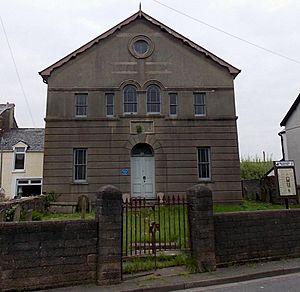Hen-Dy-Cwrdd facts for kids
Hen-Dy-Cwrdd (which means 'The Old Meeting Place') is an old chapel in Trecynon, Aberdare, Wales. It was a special place for people who followed the Unitarian faith. Services there were always held in the Welsh language. Today, the chapel is no longer used for services, but people are working to fix it up.
Contents
The Chapel's Beginnings
Hen-Dy-Cwrdd is one of the oldest places of worship in the Aberdare area. It was built in 1751. This was before the big industrial changes in Wales. Members from another chapel, Cwm-y-glo, helped start it. They built it on land rented from Theophilus Richards.
The first chapel looked like a simple cottage or a small inn. It had stairs on the outside. About 50 to 100 people could fit inside. By 1853, around 60 people were regular members.
Early Leaders and Their Ideas
Some important and brave ministers served at Hen-Dy-Cwrdd. One was Thomas Evans, also known as Tomos Glyn Cothi. He was a weaver from the Teifi Valley. He helped Unitarianism grow in his home area.
In the early 1800s, Thomas Evans became known for his strong beliefs in social change. He even translated a famous French song, La Marseillaise, into Welsh. Because of his ideas, he was put in prison in 1811. After he was released, he became the minister at Hen-Dy-Cwrdd. He stayed there until he passed away in 1833.
After Tomos Glyn Cothi, John Jones became the minister. He served for 30 years until 1863. John Jones was also very active in politics. He wrote for a Welsh newspaper called Udgorn Cymru, which supported the Chartist movement. This movement wanted more rights for working people. In 1847, he helped start Yr Ymofynydd. This is a Unitarian magazine that is still published today.
A New Building for the Chapel
In 1861, the original chapel building was taken down. A much larger chapel was built in its place. Even though it was designed to be simple, it looked like many other chapels from that time.
Leaders in the 1900s
E.R. Dennis
In 1916, E.R. Dennis (1882-1949) became the minister at Hen-Dy-Cwrdd. He was from Aberdare. He had studied at Carmarthen Presbyterian College and became a Unitarian. He officially started his role on May 1, 1916.
Dennis was the minister at Hen-Dy-Cwrdd for over 30 years. He loved music and drama. He even helped start a small theater in Aberdare called Theatr Fach.
D. Jacob Davies
In 1945, D. Jacob Davies (1916-1974) took over from Dennis. Davies was a poet and believed in peace. He became well-known in Wales as a journalist and a broadcaster. He was also the editor of the Yr Ymofynnydd magazine for more than 20 years. He wrote a book about the 200-year history of Hen-Dy-Cwrdd.
Important People from the Chapel
Some famous people were members of Hen-Dy-Cwrdd. These include:
- Griffith Rhys Jones (known as Caradog), a musician and conductor.
- Rhys Hopkin Rhys, who owned land and worked with coal.
- W.W. Price, a historian who wrote about the Aberdare Valley.
The Chapel's Recent History
The chapel building itself closed in 1994. However, the Unitarian community continued. The members moved to Highland Place Chapel in Aberdare. Eric Jones continued to be their minister until he retired in 2004.
After the chapel closed, the Welsh Religious Buildings Trust bought the building in 2005. Since then, people have been working hard to restore the building and make it new again.


